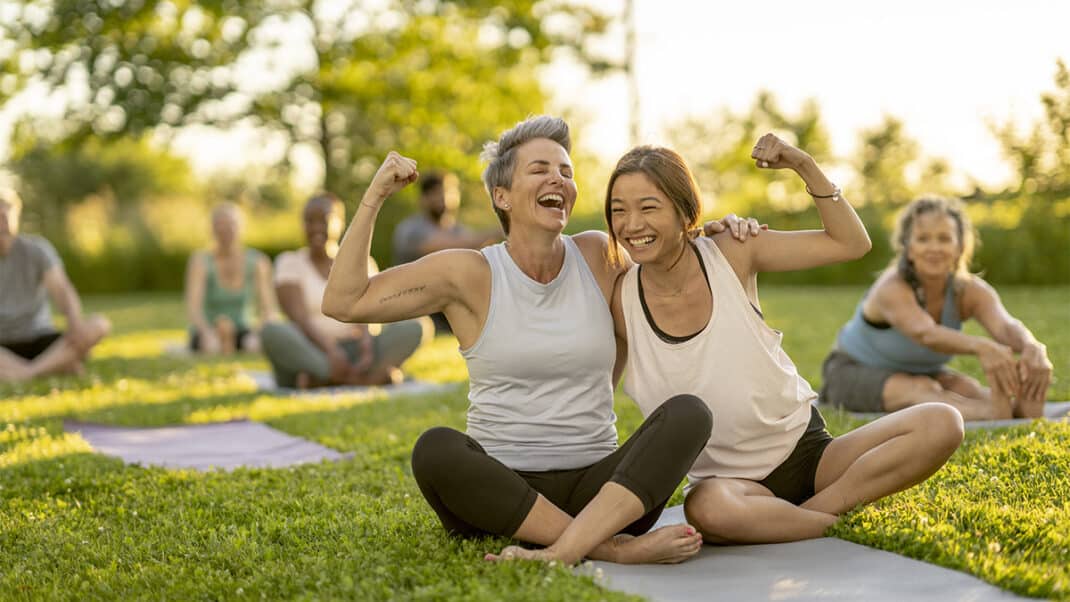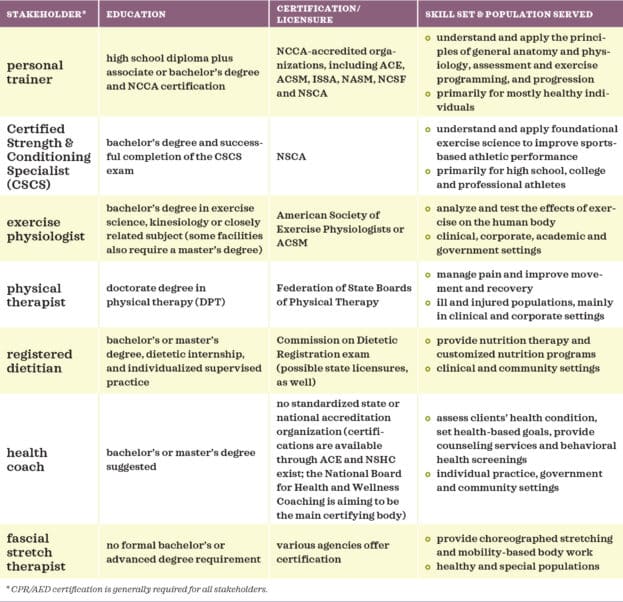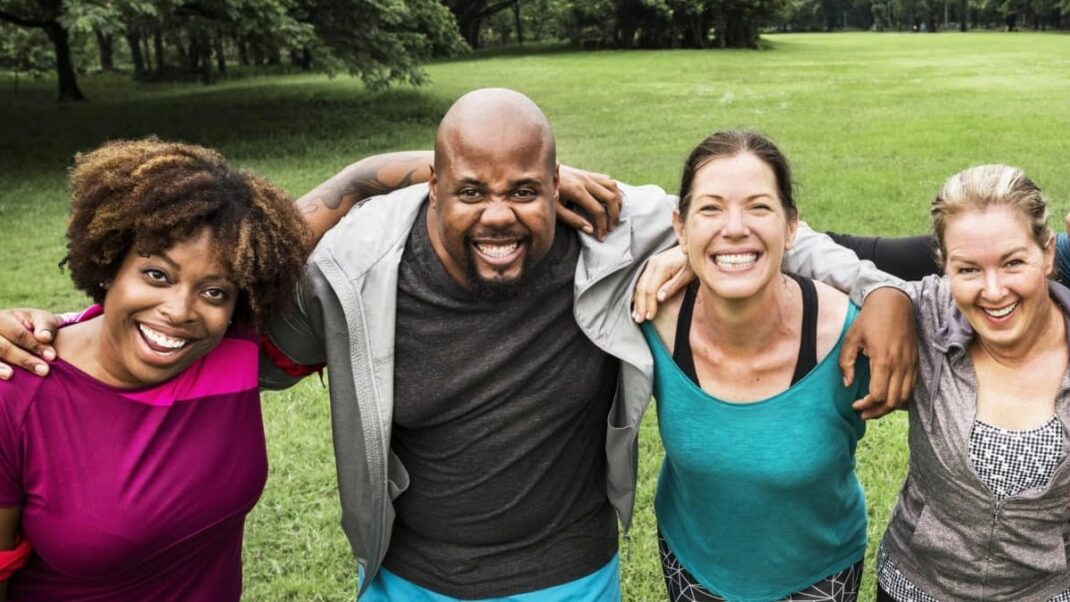Becoming a Holistic Wellness Industry
A holistic mind-body approach rises as our new industry model.

We have reached a critical juncture in our industry for more holistic wellness: More people are motivated to exercise to benefit their mind than to benefit their body. According to Exercise Trends—US—2021, a report from the research company Mintel, 78% of Americans named “mental/emotional well-being” as their top reason for working out (Club Industry 2022).
What does this mean for our profession? For starters, it means we must widen our current knowledge and practice base. While many of us entered this career due to a passion for fitness and nutrition, we must meet today’s new consumer where they are—at the junction of mind and body wellness. Success will require taking a more holistic wellness and human-centric approach that layers on knowledge of the emotional, social and mental wellness perks of exercise—and knowing how to maximize each element in every session.
That doesn’t mean that guiding workouts and coaching nutrition aren’t crucial. They are! They’re just no longer enough for many clients. This is a good thing. The more reasons people have for talking to us, the healthier our businesses and profession will be. But we must rise to the challenge, and upskilling in key areas is essential. As our industry transcends, so must we.
Exercise and Mental Health
Mental health is the status of a person’s condition in relation to their psychological, social and emotional well-being. The desire for improved mental health as a core reason for exercising was growing even before lockdowns shook our world (see “How We Got Here,” below). Anxiety, depression and feelings of loneliness were not birthed from the pandemic; rather, the pandemic exposed a wound that had been open for some time, but that had not been given much attention.
In the United States, barriers such as access and affordability have left many struggling to meet mental health challenges for years (Coombs et al. 2021). The drastic lack of resources and attention for mental health was exacerbated during the pandemic—in part because being confined with our thoughts and concerns led more people to seek help for new and existing issues. Since then, those in all walks of life and professions are beginning to see how important mental health resources are for the human experience.
Alongside this rise in awareness, exercise as a treatment for mental health has surged in importance across the globe. From TED Talks, apps and so much more, people are now seeing the essential nature of exercise as a force for good mental health. When you exercise, you provide significant increases to your alertness, mood and ability to help alleviate symptoms related to anxiety and depression (Schuch & Stubbs 2019).
See also: Sell Mental Health and Wellness, Not Exercise
Exercise and Social and Emotional Health
Social health is our ability as humans to interact and create meaningful and lasting relationships with others. Emotional health is our ability to sense our feelings and have appropriate mechanisms to cope with the daily stressors of life.
Mental health has suffered greatly for so many the past few years, and we have all become hyperaware that our social health and emotional health are tied to our mental well-being. When gyms and health clubs closed, it became clear that these facilities are so much more than just a place to exercise; they also provide important outlets for social and emotional connections. The same is true for other community gathering spots such as churches, parks and concert venues. Even as these places reopened, they did so in a more limited and safety-focused capacity. We’ve always been social and emotional animals, but now we really know it—and we crave connections more than ever.
Gyms and health clubs are a social and emotional environment for fitness and wellness professionals, as well. As our presence in club environments has grown, we’ve seen a desire from the consumer to create deeper relationships and community with us and other stakeholders in these environments. If you’re a fitness professional, you’ve heard it firsthand: Clients or class participants often tell you intimate and emotional details about their lives—and in many cases, professionals and participants develop not only strong working relationships, but also strong and meaningful friendships.
Exercise and Spiritual Health

Spiritual health involves inclusion of practices that help an individual to expand their sense of purpose and meaning in life. While this is often thought of as a religious experience (and it can be), spirituality encompasses a spectrum of ideas, philosophies and practices from various cultures.
Fitness and wellness participants have always sought some form of spiritual health through physical activity, such as yoga. While there has been very little research in this area, existing studies indicate a strong positive correlation between the practice of yoga and spiritual and physical outcomes (Csala, Springinsfeld & Koteles 2021).
In addition to a growing interest in yoga, more clients are requesting us to add in meditation-based classes and to spend more time outdoors—especially since the pandemic forced us to slow down and contemplate the larger purpose of our lives. Today’s consumers want to occasionally disconnect from the busy nature of their lives to seek guidance, buffer the incessant stressors of life and deepen connections to things that are greater than themselves. Research backs the importance of spirituality in that it “plays a cardinal role in enhancing sporting performance, personal growth, and well-being” (Roychowdhury 2019).
The fitness and wellness professional must be able to hold space for those who want to be in these more spiritually based environments. Additionally, we need to do so in a way that’s inclusive and welcoming to all cultures and customs. Holding space and being sensitive to our clients’ spiritual practices and customs is critical to both retention and more holistic wellness.
Meeting the New Demand for Holistic Wellness
The growing demand for holistic wellness services from fitness professionals—beyond physical and general nutritional guidance—necessitates a variety of new initiatives from our industry.
On a macro level, the fitness profession must become an integral part of the allied healthcare industry. One reason gyms and health clubs closed during the pandemic was because our public institutions (and the people in government and politics who decided our fate) did not see our industry in the same essential light as they saw other allied healthcare services, such as physical therapy or medical practices.
The global health, fitness and wellness industry is valued at over $4 trillion (McGroarty 2018). Still, the essential nature of our industry has come into question. Why? Just a few of the reasons include poor regulations around marketing; a lack of protection for—and transparency with—consumers; the proliferation of pseudoscience; the lack of research on the costs and financial benefits related to physical fitness (or a lack thereof); and an inconsistent industrywide demand for definitive safety measures (Tiller, Sullivan & Ekkekakis 2023; Quaglio 2022).
On a micro level—and to become a respected member of the allied health team—fitness professionals need to
- properly identify the stakeholders in our industry;
- require certification as a minimum standard for practice; and
- push for degreed pros for specialty services (see “Stakeholder Specifics,” page 35).
We also need to revamp vocational and traditional university programs to include more human-based “soft” skills that help us to understand and support our clients’ mental, emotional, spiritual and social health as we continue to deliver the essential fitness and nutrition guidance that inspired many of us to enter the field.
See also: The Essential Role of Fitness and Physical Activity: Hope for the Future
Fitness and Wellness Industry Stakeholders
Who are the professional stakeholders in our industry? We haven’t done a great job in defining the specific levels of entry and expertise in our profession. That’s information that consumers need to make a more informed decision about whom to work with.
For instance, clients commonly seek out the service of a personal trainer for weight loss purposes. However, a personal trainer without a background in nutrition science is not the proper individual to provide accurate guidance on weight loss. Because evidence shows that exercise is a poor mechanism for weight loss (Swift et al. 2018), weight loss advice should come from a registered dietitian or a personal trainer with qualification in nutrition science. But how would a consumer know this? It’s just one example of why we must do a better job of educating people on the best options to meet their holistic wellness needs.
Certification and Advanced Degrees
Current standards for entry into the fitness profession are extremely low and outdated. In fact, we are living in the Wild West of the profession, where the minimum standard of entry varies drastically depending on where you live. While there are health club operators and employers that insist on higher certification standards for employment, many commercial, boutique, residential and community health clubs don’t have strict accountability measures to ensure that each fit pro hired obtains and maintains certification.
The work of the National Commission of Certifying Agencies (NCCA) and the Coalition for the Registration of Exercise Professionals is a step in the right direction, but there is no agency providing strict enforcement of certification status on a regular basis in relation to employment (Bedosky 2018). This task is often up to HR departments, club operators or directors of clubs—who may or may not be keeping up with these standards. To be viewed as an essential profession, we must begin to create stricter and more standardized requirements.
For example, a nurse or physical therapist who is licensed in one state cannot just go to another state and begin practicing. There are specific state guidelines, and these professionals will likely need to become relicensed to work in a different state. If nurses or PTs decide to not maintain licensure or to relicense in accordance with the requirements in their new state, they will not be allowed to practice, period. The same holds true if they stay in their home state but let their license expire. They may not practice until they become current again.
No such mechanism of oversight or accountability exists within the fitness industry. If a fitness professional’s certification lapses, there is no enforcement entity barring them from working; it’s up to the discretion of their employer.
Isn’t it time that we make certification the minimum level of entry into the fitness realm? Isn’t it time that facility owners, commercial club operators and hiring managers require this minimum certification standard for all their fitness staff?
Finally, to meet the needs of special populations (higher-risk clients and those with chronic diseases, for example), we need to push for even greater levels of education, including bachelor’s and more advanced degrees. Again, this mirrors best practices in other allied health areas.
This approach allows us to better match stakeholders with clients. Fitness professionals with minimum entry-level certifications are best matched with those who are ostensibly healthy and at low risk for chronic disease and dysfunction. So many of our consumers, however, are at high risk and need higher-skilled and more-educated professionals (Stack 2022). To remain competitive in this industry—and offer the best possible outcomes for our clients—more of us would benefit from pursuing advanced education and additional certifications.
Human-Based Skills Curricula

The past and current curricula in most vocational and traditional university settings for future fitness and wellness stakeholders does not meet the demand for current and future consumers.
If you examine the exercise science, health and human performance or kinesiology departments of most places of higher learning, the curriculum is focused on a traditional approach. There are courses in anatomy and physiology, exercise physiology, biology, biomechanics, motor learning, and other “hard science” subjects. Often there are one or two courses on psychology and behavior modification, but the overwhelming focus in educating the future exercise professional remains on the physical.
But to effectively apply this knowledge to help our clients with holistic wellness, we must also know how to interact with them and be better communicators of the human experience—and those skills are currently getting short shrift.
We need to fully overhaul our formal education programs for future exercise professionals to reflect the holistic wellness needs of consumers. Mandating more “soft science” courses in topics such as resiliency, therapeutic communication, basic counseling, intrapersonal and interpersonal communications, psychosocial dynamics of exercise, and world spiritual practices is a good place to start. These courses should be front-loaded in the curriculum, meaning that they should be required during the first and second years of school in traditional 4-year universities and in the first block of courses in vocational schools. This will provide a solid foundation for the future fitness professional on which they can continue to improve themselves socially, emotionally and spiritually throughout their educational journey and beyond.
Certification organizations also must consider adding more courses and testing content that focus on social, emotional and spiritual applications, ensuring that stakeholders have ongoing growth and development in these areas. Too many certification organizations continue to foster less rigorous testing standards, as well as content that doesn’t truly meet the needs of the stakeholder or the consumer.
The minimum entry standard should include a variety of courses that delve into the more nuanced and significant challenges of living in our ever-evolving world.
What You Can Do Now
While our industry has some work to do to level up stakeholders to meet current and future holistic wellness needs, there are some things fitness professionals can do right now to strengthen proficiency in connecting exercise with social, emotional and mental health:
- Explore mentorship opportunities and counsel from mental health and wellness professionals. Reach out to professionals you admire, or seek out experts in social work, psychotherapy and occupational health.
- Tune in to a variety of audio/visual resources such as podcasts and webinars. Podcasts such as The Wellness Paradox, Move to Live More and The Ultimate Coach are excellent resources that tackle topics such as integrating behavior change into training sessions, enacting policy change in fitness and promoting essentialism for the fitness industry. Additionally, the Wellness Think Tank Webinar is an excellent resource for networking with health professionals.
- Pursue additional certifications that focus on health behavior change. Organizations such as ACE and NASM have behavior change specialist certifications.
- Regularly attend fitness-based conferences to increase your knowledge base and to focus on being socially and emotionally present with your colleagues.
Remember Your Scope of Practice
While we expand our knowledge base and work toward transcending fitness, we must remember to stay within the scope of practice of our individual skill set, certification and academic training. It would be incredible if every stakeholder was formally trained and certified in all areas of work within the health and wellness industry, but that’s never going to be the case. It’s imperative, then, to refer out consumers for services that we are not trained to provide.
One thing that’s in scope of practice for all stakeholders in our industry, however, is the ability to bring compassion, care and sensitivity to their day-to-day interactions. You may not be a mental health therapist, but you can learn therapy-based principles that will equip you to become a better listener, companion and caretaker of your clients. You may not be a registered dietitian, but you can be sympathetic, warm and open to listening to the consumer’s struggle with nutritional practices. You may not be a spiritual guide, but you can be open-minded about how spirituality affects their health and wellness practices.
Becoming Essential—and a Better Human
Increasing the rigor and quality of education in the varied pathways in our industry will increase the essential nature of our industry—particularly if we layer on an expanded mental, social, emotional and spiritual knowledge base to achieve holistic wellness. This can help us be more successful as an industry and as individuals. And here’s the bonus: When you become a more well-rounded, compassionate, loving and present professional, you will also become a better human for your family, friends and community.
See also: Making Fitness Essential
Stakeholder Specifics
Below is a list of key stakeholders in our industry and their respective education, certifying organization(s), and skill set and setting. Understanding these distinctions will help us match our skills to various consumers’ needs.
How We Got Here
In many ways, the growth of technological innovation has created a strange paradox with our biological and anthropological history as humans by improving our prosperity in many ways—while impeding our physical health. In ancient times, exercise was essential for daily survival—and in some sectors of the world, it still is. From digging to hunting and shelter building, our ancestors engaged in functional fitness out of necessity. However, industrial and technological advancement reduced humans’ need to exercise to put food on the table or a roof over their heads. As this digital revolution and transformation accelerates in pace, our physical movement as a culture continues to slow. What’s more, humans in developed nations have become accustomed to an economy of comfort. It is no wonder that we now have a low percentage of regular exercise participation. The “Uberization” of services (with nearly every want or need delivered to your doorstep), along with a proliferation of poor nutritional and sleep practices, has led to a rise in cases of chronic diseases such as cardiovascular disease and diabetes (Makarem et al. 2022). And that was all before the COVID-19 pandemic. Early on in the pandemic, the positive role of exercise was severely downplayed; gyms and health clubs were closed for long periods of time. While these closures dealt our industry a devastating blow, a strange yet beautiful thing happened: Humans began to use exercise as a treatment for mental, social, emotional and spiritual growth. This led to a critical awareness of exercise as an essential service, not merely a luxury, hobby or means for aesthetic bodily improvement. Though federal, state and local governments classified gyms and health clubs “nonessential,” the public has largely rallied to our defense, demanding that our doors open and remain open. People everywhere now are embracing and desiring that exercise become more than what it has been for decades. The public is now asking fitness and wellness pros to meet a new need for a more holistic model. Exercise was always a great treatment for mental, emotional, social and spiritual growth. But as the saying goes: You don’t know what you’ve got ’til it’s gone. Humans everywhere have finally realized the full potential and treatment that exercise provides.
References
Bedosky, L. 2018. The future of personal training may be regulation, certification and integration. Club Industry. Accessed Feb. 24, 2023: clubindustry.com/trends/future-personal-training-may-be-regulation-certification-and-integration.
Club Industry. 2022. Mental health is the top reason Americans exercise, per Mintel report. Club Industry. Accessed Feb. 24, 2023: clubindustry.com/fitness-studies/mental-health-top-reason-americans-exercise-mintel-report.
Coombs, N.C., et al. 2021. Barriers to healthcare access among U.S. adults with mental health challenges: A population-based study. SSM—Populations Health, 15 (100847).
Csala, B., Springinsfeld, C.M., & Koteles, F. 2021. The relationship between yoga and spirituality: A systematic review of empirical research. Frontiers in Psychology, 12 (695939).
Makarem, N., et al. 2022. Redefining cardiovascular health to include sleep: Prospective associations with cardiovascular disease in the MESA Sleep Study. Journal of the American Heart Association, 11 (21), e025252.
McGroarty, B. 2018. Wellness now a $4.2 trillion global industry—with 12.8% growth from 2015–2017. Global Wellness Institute. Accessed Feb. 24, 2023: globalwellnessinstitute.org/global-wellness-institute-blog/2018/10/06/wellness-now-a-4-2-trillion-global-industry/.
Quaglio, L. 2022. Becoming essential. Fitness Journal, 19 (4), 24–29.
Roychowdhury, D. 2019. Spiritual well-being in sports and exercise psychology. SAGE Open, 9 (1), 215824401983746.
Schuch, F.B., & Stubbs, B. 2019. The role of exercise in preventing and treating depression. Current Sports Medicine Reports, 18 (8), 299–304.
Stack, M. 2022. Five steps to the professionalization of the fitness industry. Club Industry. Accessed Feb. 24, 2023: clubindustry.com/step-step/five-steps-professionalization-fitness-industry.
Swift, D.L., et al. 2018. The effects of exercise and physical activity on weight loss and maintenance. Progress in Cardiovascular Diseases, 61 (2), 206–13.
Tiller, N.B., Sullivan, J.P., & Ekkekakis, P. 2023. Baseless claims and pseudoscience in health and wellness: A call to action for the sports, exercise, and nutrition‑science community. Sports Medicine, 53, 1–5.
Darian Parker, PhD
Darian Parker, PhD, earned his doctorate in sports education leadership with an emphasis in behavior modification, his master’s and bachelor’s degrees in kinesiology, and his personal trainer certification through the NSCA. During his 20 years in the fitness and wellness industry, he has worked extensively in both the academic and private club sector as a director of education for a Career College, general manager of a high-end luxury residential fitness club and national director of fitness for a global leisure management company. Currently, Darian is the co-owner of Epic Leisure Management and has a live virtual personal training business where he works with many prominent U.S. business leaders. Darian is also the host of Dr. D's Social Network, a podcast devoted to genuine, open and honest conversations with people from all over the world.





